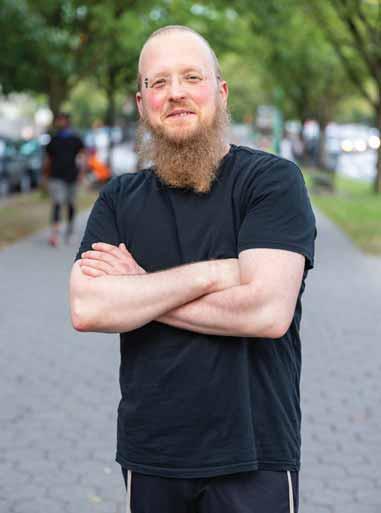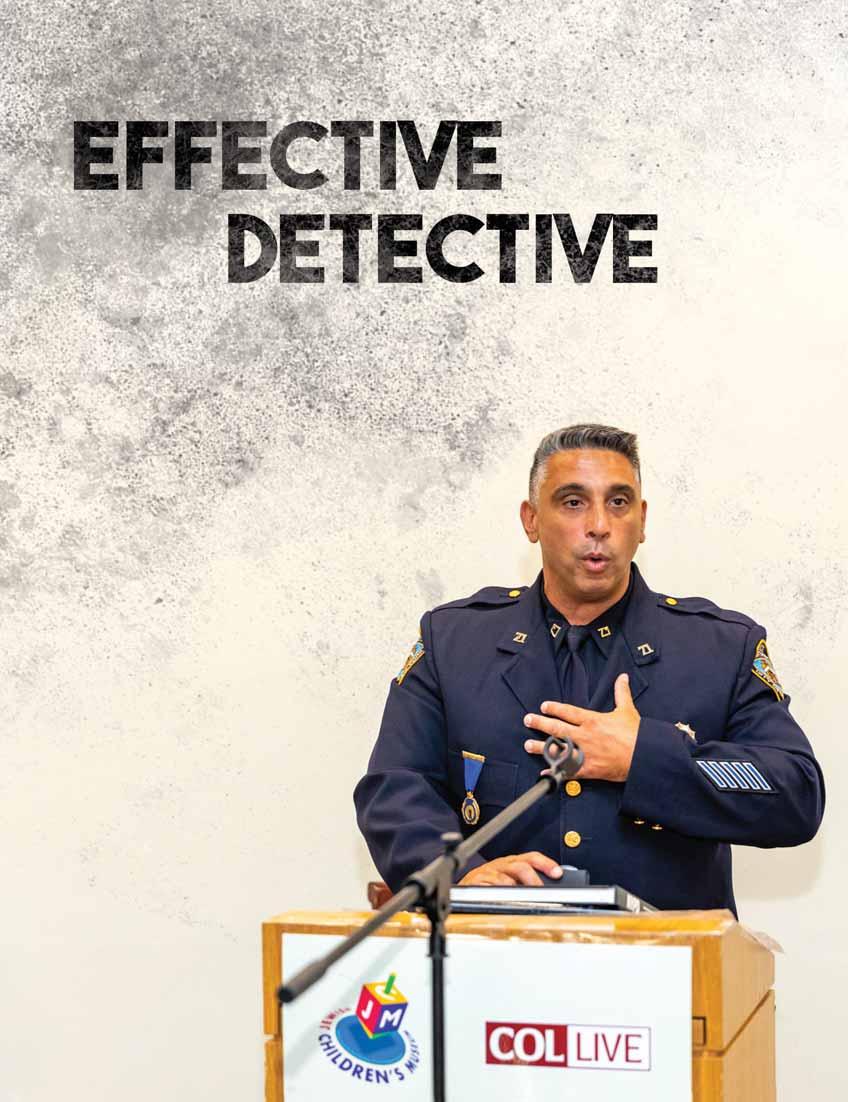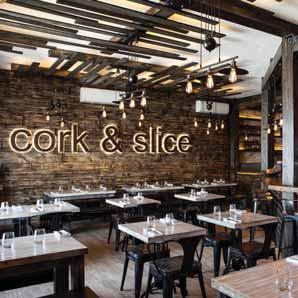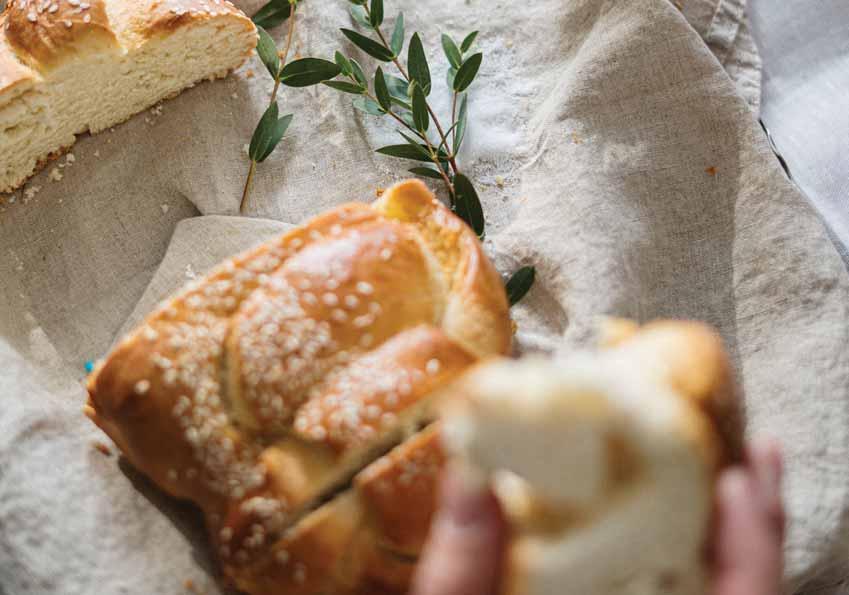
42 minute read
Weekly Features
MIRA CLESI had already been quarantining for a few months before I started feeling symptoms of Covid. My son had undergone his 2nd open heart surgery in Boston, so my family had been wearing masks and gloves with avid hand washing routines for a few months before coronavirus was even mentioned. into an induced coma and onto a ventilator. I stayed in the hospital for a total of 9 weeks. extra money for a private room in a hospital, yet I would have given anything for a roommate, just another person to talk to. None of the patients had anyone with them. We were completely at the mercy of the staff, the doctors and the nurses. There were some amazing doctors and nurses who treated me with so much care, so much patience. They were invested in my healing. They would speak to my wife and keep her up to date about THANK YOU HASHEM (AND HIS ANGELS) ALONE BUT WITH OTHERS: SHLOMO RECU 4 SURVIVORS OF COVID-19 SPEAK ABOUT THE HARDSHIPS, THE KINDNESS, THE LESSONS AND THE MIRACLES THEY EXPERIENCED * AS TOLD TO DANIT SCHUSTERMAN Photo by Menush Amit On March 17, I came down with exactly what was happening, a fever. My body felt miserable. My memories of being in what medication I was on, how I I was coughing a lot and found the hospital are few, but I was doing. it difficult to breathe. On March 23, I went to the hospital. The first week I was conscious. In the next 2 weeks, I was put do remember the feeling of loneliness. For 8 weeks, I was alone in a hospital room. I found it ironic how people will pay There was a physician assistant (PA) who would check in on me all the time. She would FaceTime my wife so she

can see and speak to me - even when I was on the respirator. There was another incredible woman named Jeanette, a patient care technician. She worked in the ICU and showed so much compassion to me and to my family during what seemed like some of our darkest moments.
Unfortunately, there were also doctors and nurses who seemed so overwhelmed and cold. They treated me more like a burden, like they were agitated any time I needed anything. These doctors wouldn't return my wife's phone calls. I had to wait 2-3 hours when I called for them.
SWhile in the hospital, Rabbi Rabbi Shimon Hecht Shimon Hecht would try to visit me but was not allowed past my doorway because of the isolation precautions. Volunteers from the Gedaliah Society brought me packages. There was so much happening behind the scenes that I only heard from my wife. Dr. Elie Rosen Dr. Elie Rosen and Yingy Yingy Bistritzky Bistritzky are truly incredible people. The rehab center that they arranged was absolutely a magical place. So much healing and growth happened through this rehab. When I’m asked how I got
Upon returning home from the hospital, Shlomo Recu jams out with fellow musicianss and community members who showed up to great him through this, I say there was no logic involved. I had no reason to believe this, but I just knew I was going to survive this. I knew I would get out and I would be okay. I remember a friend calling me and telling me that hundreds of people are saying Tehillim and davening for my refua. I remember thinking, ‘why are they davening for me? I'm going to be okay. They need to daven for the people who are really sick!’ I only realized how close to death I really was once I began to truly get better. I used to live my life planning each day by the minute. I'd calculate my days so that every moment was utilized. This experience has taught me that ‘I need to take my foot off the gas.’ Hashem is clearly in charge. I learned that I have limits. All I can do is my best and to go with the flow. I also realized that we are all dealing with something. Coronavirus is just one of the things that we dealt with. We need to have respect for each other and to know each other. We need to be there for each other because we really don't know what each other is going through. When we know each other, we can be there for each other, we can help each other.


HIS WIFE, CHAYA RECU
My baby had just survived his second open-heart surgery. Now my husband was in a medically induced coma on a ventilator. My only contact with him and how he was doing was through the hospital. How did I survive this? Hashem sent the most amazing people into our lives.
Friends and neighbors would drop groceries on my doorstep all the time. Bikur Cholim of Crown Heights are angels in disguise. Dinner was dropped off at my home every night. I couldn't believe that people who had no idea who I was were taking the time to make my family a delicious hot dinner. Two good friends of mine arranged to have a nutritious breakfast dropped off for me every day for a month. It didn't seem real. While Shlomo was in a coma, Dr. Rosen encouraged me to FaceTime with him. This proved to be essential. When it came time to get Shlomo off the ventilator and the doctors had a few consecutive days of failed attempts, I talked him through it over FaceTime for 3 hours. Baruch Hashem, it worked.
When I felt I just couldn't take it anymore, I would call the Gedaliah Society’s mental health hotline. They were always so discreet and I felt like they were giving me a lifeline.
The Jewish community as well as the Crown Heights community is just amazing. You don't know how amazing they are until you need them. And they show up. To this day, when we walk down the street we have random people greeting us, smiling, wishing us well. It is something I will always be humbled by.
NOT TOO OLD TO RECOVER: CHANA LIPKIND
In the beginning, I started feeling not well. My health deteriorated pretty fast after that and I don't remember much of the experience in the hospital. I know I was on a ventilator and was intubated.
While in the ICU, I remember many hallucinations. I remember one day hearing two voices. One male and one female. The male was saying to leave the ventilator in, and the female was saying to take it out. Baruch Hashem, it was taken out and I was slowly on the road to recovery. What got me through the long and lonely days in the hospital was having somewhat of a routine. I didn't allow myself to dwell on the fact that I wasn't home
Photo by Shmuel Amit
care in the hospital. After I returned home, I had 6 weeks of physical therapy. I really thrived through this. It really helped my healing process. Interestingly, one of my biggest challenges throughout this experience was the following:


I am 77 years old. I have never with my children. Photo by Mo Gelber There was no end in sight. I didn't know if I was going to be there for three more days or three more months. My daily routine really helped me through this. I was very blessed to have excellent thought of myself as an ‘old lady.’ But in the hospital and in rehab, I was treated like one. I was constantly told by the doctors and therapists how lucky I was, and how so many people ‘my age’ did not survive this. It took a lot of work on my part to get out of the mindset of ‘old lady’ and get back to my usual self. My husband passed away 24 years ago. I have since been in the mindset that ‘I can do this. I can deal with this. I will deal with my emotions but I still need to keep going.’ This really helped me get through so many difficult moments.
I really had an amazing team running the show while I was out of commission.
My oldest daughter worked round the clock researching an experimental drug. My youngest daughter kept the house in order and made sure to pay the bills. I had people from all over the world davening for me. To this day, I am still humbled just thinking about how many people davened, sent flowers, candy, and showed they cared in all different ways. Today, I am so much better. I definitely feel tired and achy sometimes and get some brain fog. But for the most part, I am slowly getting back to myself. We don't know much about this virus. We don't know if we can get it again or not. We need to be responsible. There are no guarantees that this can't happen again, so we have to be careful.

THE MIRACLE MEZUZAH: ELIEZER GOLD
I came down with the virus on Purim. After 9 days at home, it reached the point that I had to go to the hospital. The first 4 days they put me in an isolation room by myself. As everyone knows, no visitors were allowed. It came to a point where there was no choice and I had to go on a ventilator and go into the ICU. I was in the hospital for 7 weeks. Yet, from the first day that I came down with the virus, until several days after coming off the ventilator, which was about 44 days, I only remember about 2 hours. Typically someone on a ventilator does not remember what happened. I had some hallucinations where I felt an ongoing battle for my life, but apparently something was pulling me back here. I now know it was the constant tefillos and mitzvahs being done for my refuah. I am so humbled and grateful to all those who davened and worked for my recovery. Thank G-d, I don’t remember that time, so I’ll let my wife relate some of what happened.
HIS WIFE, BASYA GOLD
During this time Rebbetzin Rebbetzin Ashkenazi Ashkenazi of Kfar Chabad called to say hello, and I told her what was happening in Crown Heights and that my husband was in the hospital. After hanging up, the Rebbetzin opened an Igros Kodesh. She called me back and said that it had been written to check the tefillin, Rashi
and Rabbeinu Tam, and to check the mezuzahs.
This was at the height of the pandemic in Crown Heights, and everything had closed. All sofrim were at home and not going into their offices. My son located a sofer who agreed to help. I called him, and he decided to take the tefillin first. He checked them and even though they were kosher, he suggested to add a hiddur to them. The hiddur that he suggested took about 10 days due to the process involved, and in the meantime, he started to check a few of our mezuzahs.
During this time, Rebbetzin Ashkenazi was calling me nearly every day to see if it was taken care of. It was before Pesach, the tefillin were a long process, there were many mezuzahs to check, and the sofer was limited in the available time. The sofer asked a Rav if he could continue to check the mezuzahs during Chol Hamoed. The Rav told him to check only 2, one bedroom and the one on the front door. The mezuzah to the bedroom was fine, but when the sofer opened the mezuzah of the front door of the house it was completely posul. Much of the ink in the ayin had completely fallen off. The ayin was in the word nishbah in the 2nd paragraph of Shema, that Hashem promises long life on the land. The mezuzah was an absolutely beautiful mezuzah and had been very mehudar, but we were told that apparently weather conditions had caused the ink to pull away from the parchment. Meanwhile, in the ICU, the doctors were having a difficult time weaning my husband from the ventilator. They had made many attempts but there were always problems, and after about 12 days of being on a ventilator, they had to put in a trach, as a person cannot be on a ventilator more than two weeks without having a tracheostomy. Rebbetzin Ashkenazi, bless her, kept calling me and could not understand what was taking so long. She later explained that she opened the Igros a second time, and the answer was to follow up and find out if what was supposed to be done was taken care of.
As soon as the sofer found the posul, I gave him another mezuzah to replace it. On Sunday Chol HaMoed, a resident doctor at the hospital told me they would try a weaning trial in the morning, and that he wanted me on the phone to speak to my husband in the hopes that it would facilitate the weaning. This was already after 24 days on a ventilator with multiple attempts to wean him with no success. On Monday morning I waited for the call, and ended up waiting the whole day as there was no way to reach the resident doctor.
Finally, on Monday at around 5:00

PM, the sofer called me and said that he checked the replacement mezuzah for the front door and that he is coming over to put it up in 10 minutes. Just as the sofer rang the doorbell, the resident doctor from the hospital called to have me on the line for the start of the procedure. I couldn’t go to the door so I sent my son in law, who was staying in the house, to go take care of the mezuzah with the sofer.
My daughter and son in law were witnesses that from the moment the sofer drilled that mezuzah in the doorpost and the sound could be heard throughout the house, that was the moment that things turned around. That was the beginning of my husband getting better. That was Monday, Chol Hamoed Pesach around 5:00 PM. The breathing trial was successful and Baruch Hashem on Wednesday, Shivi Shel Pesach, he came off the ventilator completely. On Thursday, the last day of Pesach he came out of the ICU, Baruch Hashem.
I must credit Rebbetzin Ashkenazi for her amazing concern and persistence in getting the mezuzahs and tefillin checked. I had so much going on, and checking the tefillin and mezuzahs is always a massive undertaking, but only because she kept calling was I able to focus on that. The sofer was very sympathetic, and even though he was closed, and had very limited time because of Pesach, he went way above and beyond the call of duty, working days and through
nights to get things done. The extraordinary ahavas Yisroel at this time doesn’t cease to amaze us. There were so many people all over the world davening and saying Tehillim. It was an actual lifesaver for which we are forever grateful. We personally witnessed the great power of Torah, tzedaka and tefillah, and how it literally saved my husband’s life and all the others who made it back. This is a time people will never forget, and it is engraved in our memories. Multitudes of people spent their days in davening, learning, giving tzedaka and saying tehillim for those who needed a refuah shleima. Was there ever such a time that so many people from all over the world were davening for so many people with such heartfelt prayers? We must remember all those kedoshim who we unfortunately lost, and our hearts go out to their families and loved ones. Our only solution and consolation will be Moshiach and the geula haamitis v’hashleima. We must demand the geula just as we demanded mercy and rachamim from Hashem during those dark and miserable days. It is an appropriate time to tell this story as we are in the month of Elul when it is customary to check our tefillin and mezuzahs. May we be blessed with a k’siva V’chasima Tova L’Shana Tova uMesuka!
DISCOVERING THE CROWN HEIGHTS HEART: LEAH R.
On March 15, both my husband and I got sick. We are in our early 30s and were both unable to get out of bed for 2 weeks. We had all the symptoms of Covid. Fever, sweating, chills and aching all over. There are actually no words that can convey what we went through on paper. There was no night or day. There was no ‘you’ or ‘me’. There were three days where I actually slept on the bathroom floor because I couldn't get up and my husband was too weak to help me. I was not having trouble breathing. But I was having a lot of trouble staying alive. Hatzalah came and wanted to take me to the hospital. I just burst into tears. There were so many people who had succumbed to this virus, I was terrified. I had young children at home, the youngest, my 4-month-old baby with health issues. Hatzalah arranged to have an IV brought to my house so I did not have to leave my children and go to the hospital. This happened at the very beginning when we had no information. I was unable to nurse my baby. I was unable to change my baby. But I couldn't drop him off at friends or family either. Amazingly, my children really took care of each other during this time. There were days when I didn't know if I would make it. Both my husband and I are not from Crown Heights. I always knew before but this experience solidified just how fabulous the Crown Heights community is. I don't think we would have had the support we had if we lived anywhere else in the world. Every single day, food, kids activities, baby formula, even baby clothes for my fast growing baby were dropped off. If I needed anything, I just had to send one text and it was dropped off outside my front door. The Gedaliah Society created a hotline right away. This type of infrastructure does not exist anywhere else. Every other community followed what we did. After 3 weeks, I started to recover. I usually have full-time cleaning help but with Covid, our cleaning person did not come. I remember when I finally had the energy to walk around, I was in shock yet still so thankful as to what my house looked like. I had no idea if my kids had bathed for two weeks, but my baby didn’t have a scratch and everyone looked healthy. Even after 5 months I have still not fully recovered. This virus is not as simple as we think. I am not back to my old self. It takes a bigger physical toll on us then we can imagine. I am in a much better place now, but going forward, we have to proceed with caution. It is very important that we do our research and realize how real this virus is. We still don't know a lot.

shulsour COMMUNITY Tishrei 5781 Edition 23 What makes a community? Crown Heights is made up of dozens of micro-communities built over decades of friendships and experience, and their members might say it needs patience and dedication. If you go to the Mitzvah Center on Troy avenue, though, you might have a different answer. The Mitzvah Center is a place of boundless energy that has built a burgeoning community in four short years. Any conversation with the remarkable “Founding Fathers” of this Shul makes it clear that this is a special place. “Instead of being on autopilot,” Gabbai Yossi Mahpour Yossi Mahpour says, “we are always trying to do new things.” The Mitzvah Center offers a constantly evolving carousel of events, helps community members connect, and keeps everyone in touch with their Mitzvah Center app. That energy is what fueled Mahpour, Shul president Yossi Yossi Chayo Chayo, and a few others to start the Shul back in Elul of 2016. “We were hanging out at someone’s house on Shabbos afternoon,” Chayo said, “and we thought, why not make a place that we can Daven and connect together?” The founders of the Shul were young, 20 years old on average, but they were driven by vision and tenacity. They made a Whatsapp group that cost $200 to join, and started construction. By Rosh Hashana they opened their small basement Shul to 60 members. By Yom Kippur, that number went up to 80. The Mitzvah Center has been running off that boundless energy since that afternoon, and they have discovered that it is infectious. Less than a year into the Shul’s existence they ran into their first major snag. The summer was coming and they needed air conditioning. Most would have gone dumpster diving for the cheapest option, but that isn’t the Mitzvah Center’s style. Instead, they got a huge air conditioning unit for ten thousand dollars, assuming that they would figure out a way to pay for it. Within 24 hours, the community had it covered. “And these are single guys,” Chayo says, “the donations were small.” Today the Mitzvah Center is at a beautiful home on 328 Troy Avenue, which they acquired in October of 2017. The young men approached this new location with their trademark grit and zest, transforming a broken down 99 Cent Store between President and Union into a magnificent Shul and Simcha hall. When they started the founders were all young and single, but as they get older the dynamic has changed. The Mitzvah Center has grown to 150 members, half of With the immense growth of the shechuna, a new series "Our Shuls" was launched on community news service COLlive.com featuring profiles of the local shuls, the driving forces behind them and the communities they created. Here are the most recent shuls featured. The Mitzvah Center


whom are married, and the Shul has had to accommodate the growing number of women in attendance.
This past Rosh Hashanah they noticed that there was not enough space for the women, and they immediately set into high gear working on renovating the Shul. The newest renovation, that will be completed before Rosh Hashanah of this year will include a women’s restroom and an expanded women’s section.
Chayo also realizes the importance of friendships

in binding the community together. He encourages his members to host large meals at their homes so that people can get to know one another. They also launched their first women’s event, a hamantash bake, this Purim. For the Mitzvah Center to provide the type of community that they are hoping to build, both men and women have to have a way to connect. The Mitzvah Center is a constantly evolving place that manages to continue attracting people with their innovative programming and welcoming atmosphere. It will be amazing to see what these remarkable men continue to do.
Getzel's shul
The images are familiar: the elderly Chossid, wrapped in his Tallis, rocking back and forth as he digs to eradicate the last vestiges of some negative trait; the young man, pacing across the worn marble, trying to wrap his mind around a Kabbalistic concept from the Shiur; businessmen, setting aside the worries and travails of the week to gather strength from the mystical beauty of Shabbos.
This is Getzel’s Shul. Among the oldest Shuls in Crown Heights, Getzel’s Shul has provided
a place for generations of Chassidim to reflect and grow for nearly 40 years. It continues to attract new members.
“It is a place that young people bring their children to show them what an authentic Chassidishe Shul looks like,” Gabbai Zalman Goldstein Zalman Goldstein says. “It is a place where people complain that the Shiur Chassidus isn’t long enough.” Getzel’s Shul was started by Rabbi Avrohom Plotkin Avrohom Plotkin in the early 1980’s as a small Shul in his basement on President street between Brooklyn and New York. They were only a few members back then, but among them were a number of illustrious and significant attendees. On Friday nights, Rabbi Yehuda Kalman Marlow Yehuda Kalman Marlow would daven there, and deliver a Shiur on Hilchos Shabbos. Another regular member was R’ Sholom Ber Gansburg Sholom Ber Gansburg who, as a Ben Bayis of the Rebbe’s household, would often tell the Rebbetzin about his Minyan. This fact led to an astounding moment when the Rebbe gave a bottle of wine for the Shul at Kos Shel Brocha. While the Rebbe would often give bottles for Chabad Houses or Shuls in other communities, this was the only local Shul to which the Rebbe gave wine. Although the connection was never stated explicitly, it has been presumed that the Rebbetzin passed the positive reports she had received from R’ Sholom Ber Gansburg to the Rebbe. From the beginning, it was clear that there was something special about this Shul. People would step in for the Shabbos farbrengen (on the weeks that the Rebbe was not farbreinging in 770), and they would keep on coming. The warmth and authentic Chassidishe environment soon drew in a large crowd, many of whom still attend the Shul until this day. When the Yeshiva began renovations on 1414 President Street about 20 years ago, they offered the basement as a space for Rabbi Plotkin’s Minyan on condition that they renovate it as well. It was at this point that the president of the Shul, R’ Shaya Boymelgreen Shaya Boymelgreen, chose to dedicate it in memory of his wife’s grandfather, R’ Getzel Rubashkin Getzel Rubashkin. “The name fits the Shul,” Goldstein says, “Reb Getzel was a warm, authentic Chassidishe Yid, and the Shul is just that.” Today, Getzel’s Shul continues to be a haven of authenticity. Shabbos davening is preceded by a well-attended Shiur in Likkutei Torah and Torah Ohr, and inspired by a Shabbos drasha by Rabbi Efraim Rabbi Efraim Mintz Mintz. After davening they hold a weekly Farbrengen, a passionate expression of Chassidishe warmth that can continue deep into Shabbos afternoon. Between Mincha and Maariv they join together in celebrating Shabbos with Seder Niggunim and the recitation of Chassidus.
The Chassidishe warmth is reflected not only in the way the congregation of Getzel Shul’s davens and learns, but in the way they act to one another. “There is quiet chessed,” Shloime Ezagui Shloime Ezagui says. As one of the Shul’s core members, he often helps people donate to one another anonymously. “A young man was sick,” he said, “and within 2 or 3 hours we had raised close to $5,000.”
In true Chassidic fashion, this Chessed is always performed without grandstanding. “There are no Baalei Gaivah, no fighting,” one member noted. Members of the shul anonymously provide a network of support for people within the community, helping people with their rent and providing loans to help with Simchas. From its humble beginnings in the small basement across the street from the Rebbe’s home to its place today as one the hidden gems of the Crown Heights community, Getzel’s Shul perhaps bears one of the closest resemblances of the shtiebel in the Shtetel in Russia, where R’ Getzel Rubashkin was raised. "from the beginning, it was clear that there was something special about this shul"

bais gimpel



The two minyanim were only a few doors away from one another, but they had a deep and profound commonality. “We wanted a place where everyone felt comfortable.” Beis Gimpel Chaim-Shmuel Leib, or just Beis Gimpel, has become a Crown Heights institution for hundreds of residents living on New York and Brooklyn avenue, but when the two small Minyanim that comprised its core members began, nobody would have imagined the impact it would have.
The first Minyan began about 15 years ago, when Reb Shmuel Leib Strauss Shmuel Leib Strauss began to have trouble making his way to Shul on Shabbos. A group of friends, including Shmuli Brashevitsky Shmuli Brashevitsky, took the initiative of helping him with a Minyan. It wasn’t easy – many of the members were walking quite a distance – but they knew Reb Shmuel Leib needed a Minyan. In 2012, nearly 3 years after Reb Shmuel Leib passed away at the young age of 66, a group of young men began a Minyan with the mission of building a Shul in which everyone felt comfortable and at home. They started small, with a group of friends that included Shloimy Greenwald Shloimy Greenwald and Shaul Dahan Shaul Dahan, and slowly grew. Only a few doors away from one another, the idea that they combined with the dwindling Beis Shmuel Leib seemed natural.
By 2014, their small Minyan had become a vibrant community that needed a new home, which they found at 309 New York avenue. As a community, they fundraised to renovate the bottom floor of the building into a beautiful shul and the Nemes simcha hall. The dedication, a landmark event highlighted by a lavish dinner and a performance by beloved singer and composer Yossi Green Yossi Green, was incredibly moving to those founding members. “For me,” said Gabbai Shaul Dahan, “the moment that they brought the Torah in, dedicated to my grandparents, was particularly moving.” The Torah, and the shul, had been dedicated in memory of Reb Gimpel Orimland Gimpel Orimland and Reb Chaim Chaim Gastfrend Gastfrend, and the fact that this Torah would be used in this space was profound. It brought to mind the story of his wife’s grandfather, Reb Gimpel Orimland, who had bid a considerable amount on one of the Hakafos in 770 on the Rebbe’s recommendation. After the following year saw him enjoy considerable success, he asked the Rebbe to suggest a bid the next year. The Rebbe recommended a paltry sum. Stunned, he asked the Rebbe the reason for the enormous drop. The Rebbe replied, “the idea is to give Tzedakah when you don’t have.” Six years later, the Shul continues its mission of building a home where everyone had a Minyan. They have two Shachris minyanim, along with Mincha and Maariv, and an Ein Yaakov Shiur twice a week. A shiur Friday night draws in many from around the neighborhood, while a Shabbos morning shiur in Likutei Torah in English at 8:45 am, children’s program, and beautiful Kiddush after davening keeps the Shabbos day Minyan crowded. The Shul even hosts a successful Sunday Kollel in honor of beloved educator, Reb Mordechai Tzvi Greenwald Mordechai Tzvi Greenwald, with topical Shiurim and a hot breakfast served. The Shul, which is beautifully maintained by Shul treasurer Mendel Sufrin Mendel Sufrin, is also rented out regularly as a popular venue for L’Chaims and other events.
Reb Gimpel’s shul draws in everyone. “It is a place where everyone feels comfortable,” Rabbi Shloimy Greenwald said. “We have people ranging from about 18 to people in their sixties and seventies. Religious, non-religious – everyone is welcome.” The way Shmuli Brashevitsky put it, “we have 9-year-olds and ten-year-olds, and we have their great-grandparents.” While most would be satisfied with the Shul’s success, Shloimy Greenwald says that they are hoping to expand their space. With hundreds of people passing through their doors on a weekly basis, he says, “We’re bursting at the seams.”
Lefferts The Lefferts Shul lies at the intersection of history and modernity. It has evolved from one of the first Shuls in Crown Heights to becoming a bastion of the Crown Shul Heights renaissance of the past decade. This incredible story can be traced back to a group of brave Chassidim and their dedication to the Rebbe’s vision. he noted that “Lubavitch was hardly represented” in would move out of Crown Heights, but the Lubavitcher Congregation Adas Yisroel – Beis Midrash Eliyahu members of the Shul advocated that the Shul remain. On Nachum, affectionately known simply as, “the Lefferts the last day of Pesach in 1969, the Rebbe began speaking Shul”, became a Lubavitch shul in 1975. of the “veritable plague…of selling Shuls and Batei Crown Heights, formerly a home to Jews of nearly every Hamidrash to non-Jews.” type of Orthodoxy, was rapidly transforming. The other For Rimler and his fellow Chassidim, this meant that the communities, many of whom had lived in Crown Heights Shul on Lefferts could not be abandoned. Together with since the twenties, were fleeing en masse in the face of such luminaries as Rabbi Yechezkel Langsam Yechezkel Langsam, Rabbi Moshe Moshe plunging real estate prices and skyrocketing crime rates. Levertov Levertov, Rabbi Zalman Gurary Zalman Gurary, Rabbi Mottel Chein Mottel Chein and It took the Rebbe’s wisdom to see that Crown Heights had to remain a home for Chassidim, and it was on his Rabbi Eliyahu Nachum Sklar Eliyahu Nachum Sklar, the Chassidim that lived on Lefferts Avenue began working to rebuild the Shul. instructions and encouragement that the Lubavitch In those early days, the Shul membership was dwindling, community of Lefferts Shul began. but their dedication to the Rebbe kept the Chassidim on Shul president Reb Dovid Rimler Dovid Rimler and his wife moved to the block waiting for a Minyan, or standing on the street to gather passers-by. As time passed, however, the Shul "we wanted a grew, and by 1975 they were able to offer to buy the building from Rabbi Teitelbaum. Rabbi Teitelbaum was place where eager to be rid of the building, and he issued them an ultimatum: they had to both take the mortgage and pay everyone felt him the sum of $9,000, or he would sell the Shul, which meant the Shul could end up being purchased by a noncomfortable" Jewish buyer. With a considerable donation from Rabbi Zalman Gurary to start them off, the group of impassioned Chassidim went door-to-door to collect the rest of the money. Rabbi Eliyahu Nachum Sklar, the beloved Chossid of the Lefferts Avenue in 1969. Calling it “the good old days,” name the new Shul Adas Yisroel. Freidiker Rebbe and the Rebbe, recommended that they the neighborhood. By 1988 the Shul community was thriving, now boasting two Minyanim and a warm and vibrant place for people At the time, the shul was called Kahal Adas Yi’Raiyim. It was to Daven. Before Rosh Hashanah of 5749, the Rebbe run by the Chentzkovicher Rov, Rabbi Shmuel Teitelbaum Shmuel Teitelbaum. declared that year to be Shnas Habinyan, and encouraged Rabbi Teitelbaum was an affiliate of Satmar, but ran his own Shuls to make efforts to expand. The Chassidim of small Shul out of the first floor of his home. Congregation Adas Yisroel took this call to action and With the rise in crime, Rabbi Teitelbaum decided that he began to fundraise. As he did for anyone that agreed to expand, the Rebbe personally gave them 100 dollars. The community collectively raised $125,000 to expand the Shul, while Rabbi Zalman Gurary donated funds to renovate and expand the Mikvah. In 1990, Rabbi Sklar, a pillar of the community, was tragically

killed in a hit-and-run on Eastern Parkway on his way to the Kollel Chabad Melavah Malkah at Ohelei Torah. Rabbi Sklar was the gabbai of the Shul, and his loss was devastating. The community honored him by changing the name of the Shul to Congregation Adas Yisroel-Beis Midrash Eliyahu Nachum.

Today, the Shul continues its mission to accommodate those following the Rebbe’s directive to strengthen Crown Heights. In the past decade, many young families have been renting and buying homes closer to East Flatbush, and they have looked to Lefferts Shul as a center of Yiddishkeit. Lefferts Shul is the closest Mikvah to East Flatbush, the Shul originally drew many people for that reason, but the Shul continues to work to make people comfortable. Is there a Shul where a former Democratic In recent years, the facade of the Shul has been renovated as a replica of 770 Eastern Parkway. They made Mikvah membership fully automated and enhanced the Mikvah facilities. They also began a Seforim collection, expanding their library to provide people with a place to study. The Shul now has four Shachris Minyanim, nightly Shiurim, and a constant flow of Chavrusas coming in to learn. On Shabbos, Congressional candidate can daven alongside a group of Biyaler Chassidim? Can a Shliach feel comfortable sending a community member to the same Shul that a group of visiting bochurim from Lakewood attend? Is it possible for a Chossid battling through a Shachris to share a table with folks attending Shul for the first time? Oholei Torah Mashpia Rabbi Nachman Schapiro delivers the The Besht might just be that place. weekly Drasha, as well as reciting a Ma’amer Chassidus on Shabbos afternoon. On an average Shabbos, you will find a diverse group of Jews gathered at the Shul. There will the be some that come for the inspiring davening, others for Rabbi Shmuel Kuperman Shmuel Kuperman’s fascinating speeches, and a fair few for Yossi Lifshitz Yossi Lifshitz’s herring and Shmuel Hahn Shmuel Hahn’s cholent. The Besht offers something for everyone. besht Beis Shmuel Tanchum, or “the Besht”, has earned a unique place in the diverse tapestry of the Crown Heights community. In a little more than a decade, it went from a weekly shiur to become a welcoming home for hundreds of Jews.
The shul was originally founded in 2009 by Rabbi Yehoshua Werde Yehoshua Werde in an attempt to engage friends that had wandered from the derech with chavrusa learning. The address was 510 Empire Blvd., which is now home to Werde’s current organization Crown Heights Young Entrepreneurs (CHYE). Sruly Clapman Sruly Clapman, a friend of Werde, was recruited to help with its operation. With time, Clapman has taken over full responsibility as President of the Besht. It has since moved down the block to its current location at 563 Empire Blvd where it has an active shul on Shabbos and yomim tovim. Clapman says they help cover the rent by renting the hall that can seat 100 people for events and simches. “The most common simches by us are Bas Mitzvahs and Brissim,” he says. “We also had interesting rental requests such as for a wedding, a Shloshim, a parent-teacher meeting and pop-up shops.” in Elul of 2011, leaving the young Shul with the daunting task of finding a Rav. “We brought in big names,” Clapman recounts. “The community asked for

Rabbi Kuperman.” Rabbi Kuperman was giving a weekly Gemara Shiur at the time, and at the community’s behest, he accepted the role of Rabbi. It has been 9 years, and the Shul has
The shul’s first Rov Rabbi Mendel Mendel Kalmanson Kalmanson moved on Shlichus to England grown exponentially. With the help of Director Yitzi Shollar Yitzi Shollar and Gabbai Yisroel Yisroel Pekar, Pekar, the Besht has become a mainstay of the Crown Heights community. The Shul hosts a lecture series between Mincha and Maariv on Shabbos day, bringing in guest lecturers to speak on a variety of topics. During the week, Rabbi Kuperman continues


to give his weekly Gemara Shiur every Tuesday night. Before the onset of the Covid-19 pandemic, the Besht also boasted an extremely popular Thursday night Kollel. They hope to bring the Kollel back soon, they told COLlive.com. The Besht is a warm and vital place for anyone in search of a community. It provides a home and a sense of community for hundreds of people who could not find that anywhere else. “I started attending the Besht as a single bochur,” a community member relates. “I was looking for a place that I could be a part of. I have been part of that community through my engagement, marriage, everything. This is a place that thousands of people have filtered in and out of, but they all think of it as home.” What is the magic formula? “First,” says Clapman, “it’s a non-talking Shul.” The Shul’s no talking policy provides a sense of sanctity to the davening and a space for authentic growth, he says. “Rabbi Kuperman didn’t want the Besht to be another schmoozing shul, that once you have children, you find a different shul where you can actually daven.” About the policy, Clapman admits, “I can’t say it’s totally silent but it’s quite effective.” Second, “There is a Rov,” Clapman points out. Rabbi Kuperman’s speeches draw many. With his trademark mix of humor, passion, and impressive scholarship, Rabbi Kuperman holds his congregants spellbound as he weaves a powerful and practical lesson from the Parsha. “And there is a huge Kiddush,” Clapman explains the third reason. At the Kiddush, the community connects over delicious salads and cholent, Farbrenging together and drawing inspiration for the coming week. The Besht is planning to have davening for Rosh Hashana and Yom Kippur and seating reservation for Tishrei will soon be available. There will be plenty of seating for women and a children’s program.
by Avraham Lobock
Detective Vinny Martinos recaps 28 years in the service of the NYPD. One of his memorable moments happened recently
One of the first assignments given to NYPD Detective Vinny Martinos Vinny Martinos when he first transferred to the 71st Precinct, was to stand guard outside a Jewish home in the Crown Heights neighborhood. Martinos first joined the force in 1992, training at the 76th precinct in South Brooklyn. In 1993, he was transferred to the 71st in central Brooklyn which covers the southern portion of Crown Heights, Wingate, and Prospect Lefferts Gardens. A short while after that, on March 1, 1994, Lebanese-born terrorist Rashid Baz opened fire on a van of 15 Lubavitch yeshiva bochurim crossing the Brooklyn Bridge, injuring 3 of them and killing 16-year-old Ari Halberstam Ari Halberstam. As a beat cop, patrolling the streets of Crown Heights, Martinos was stationed outside the Halberstam residence being visited by a slew of elected officials and community members during the Shiva. Martinos vividly remembers the kindness shown by Mrs. Devora Devora Halberstam Halberstam, Ari's mother, during that time. "I’ll always remember when her son was shot," he says. "Today, I consider Devorie family, but back then she didn’t know me. She would come to offer me tea. She just lost her son, and yet, in that heartwrenching time, she was showing such hospitality.” That initial courtesy has developed into an ongoing



A Retirement Salute event for Det. Vinny Martinos at the Jewish Children's Museum in Crown Heights was attended by community activists, elected officials, members of the NYPD and special guest NY Police Commissioner Dermot Shea

collaboration for the benefit of the Jewish community in Crown Heights with Martinos being appointed in 1999 as community affairs officer and Halberstam becoming an outspoken law enforcement activist, 71st Precinct Clergy Liaison and an honorary NYPD Commissioner. The connection came full circle this past month when Martinos announced his retirement. Halberstam organized hosted a community farewell salute at the Jewish Children's Museum, co-hosted by Mica Soffer, CEO and Publisher of community news service COLlive.com.
It was an appropriate send-off for Martinos who has taken an active role in protecting the community - at times, almost paying a personal price. One such example was in the 90s at the height of the crack epidemic. Under the orders of the newly elected mayor, Rudy Giuliani Rudy Giuliani, the police at the 71st Precinct were tasked with cleaning up the streets. "I’ve been shot at, but the bullet only hit my car," he recalls one instance. "And then there was a woman who threw a molotov cocktail at my partner and me. I happened to turn just in time to see the molotov cocktail coming at us. When G-d wants to intervene, He intervenes in the most amazing ways: the wad of toilet paper that had been used as a fuse sputtered out, leaving us unscathed. G-d had a plan for me, and He wasn’t ready for it to end yet." Martinos has indeed worked to make the most of the time granted to him. In addition to crime prevention and responding to the local waves of anti-Semitic attacks, he helped facilitate major public events and communal affairs.
One of those events was the Great Parade on Eastern Parkway which restored the annual Lag BaOmer event to its previous glory. "Many coordinators with the NYPD insisted that it could not be done, but I knew it was important," he says. He sat down with community leaders and organizers and planned the event from start to finish.
Another major annual event was the West Indian Day Parade and the pre-parade J’ouvert on Labor Day. He mentions with pride that, since 2017, there has not been a shooting during the happening. Historically, this has been an extremely violent event in Crown Heights, but the 71st precinct brought the violence down dramatically. Preventing violence against the Jewish community has been a big part of Detective Martinos' job. When the “knock-outs” began in 2014, the police department stepped into high gear to protect people from physical attacks. They added patrols at the street corners and made dozens of arrests.
“When it turned out that it was kids doing it, we went to the schools," Martinos says. "We gave lectures and classes at the schools and explained what they were doing. Kids don’t realize the effect of their actions. That pretty much stopped it.” 2014 also saw the shocking stabbing of Levi Rosenblatt Levi Rosenblatt in 770 Eastern Parkway. With all the rumors swirling around, many feared that it was a terrorist attack, and Martinos was tasked with easing tensions in the Jewish community. “We explained that the threat was gone, and we were able to put the community at ease.” Over the years, he worked closely with community institutions and schools and individuals such as Halberstam, Rabbi Chanina Sperlin Chanina Sperlin of the CHJCC and Rabbi Yehuda Yehuda Krinsky Krinsky, among many others in the Jewish as well as in the West Indian and black communities. "The more people I have under my tent, the better off I am," he explains as his motto. One of the most memorable moments of his career only happened this past year during the Covid-19 pandemic. It was the passing of Rabbi Leibel Leibel Groner Groner, one of the most prominent figures of Lubavitch of the last generation who served as the Rebbe's longtime secretary. Martinos was tasked with making funeral arrangements and found it difficult to conceal his personal feelings. "I always turned to Rabbi Groner for perspective and input into the Chabad community," he says. "The way the whole community came out for the procession was something that I'll never forget. I cried as well,” he says. Throughout his illustrious career, Detective Martinos saw easing tensions between the diverse communities as one of his primary accomplishments. He would often have to negotiate among community leaders, trying to make sure that everyone was happy. "I had to make decisions that are best for everybody. With G-d watching me, I’ve been able to find a balance with the community." Martinos left the force at a time when it is under heavy scrutiny and dealing with financial cutbacks. "Politicians tear down the building without having blueprints for a new one," he says in reference to calls to Defund the Police.

He notes that 2020 has seen 5 homicides and 28 shootings in the 71st Precinct alone, up from the 2 homicides and 11 shootings in 2019 at the same date. Other precincts are much higher. But as a resident of New York, Martinos doesn't give up on the Big Apple. "My family lives here, I live here. You guys live here. We have to go out and vote. We need to make it better." Thanks to him, Crown Heights is better than it was.
Changing of the Guard: Outgoing Detective Vinny Martinos visits the Rebbe's Ohel with incoming Community Affairs Officers Mike Baratta and Charles Davis




























